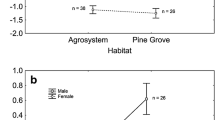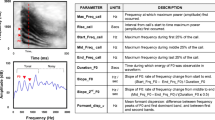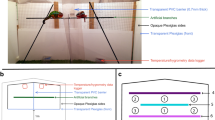Abstract
Dewlaps of Anolis lizards are complex multicomponent signaling devices that have been intensively studied. Yet, the functions and multiple messages conveyed by the dewlap remain largely unknown. Here, we assess some aspects of sexual identity, individual quality, and social status that may be signaled by the dewlap in both sexes of Anolis sagrei. In addition, we investigate whether diverse facets of dewlap signaling provide additive information (redundant message hypothesis) or highlight different characteristics of the sender (multiple-message hypothesis). To do so, components of dewlap design (area, color, and pattern ratio) and use (dewlap extension frequency during intersexual context) were quantified and investigated for relationships with sexual identity (sex), individual quality (performance and health state measurements), and social status (mirror-motivated aggression). First, we found that body size together with relative dewlap area and color act as redundant messages in the advertisement of sexual identity. Second, we found that dewlap coloration in the center and edge region signals aspects of individual quality, specifically health state, but only in males. The dewlap center and edge acts primarily as redundant signals, at least for body condition and immune response. However, different color components irrespective of dewlap region convey nonredundant information about aspects of health state in males, supporting the multiple-message hypothesis. Surprisingly, dewlap use in A. sagrei males conveyed no information about the tested quality measurements nor about mirror-motivated aggression. Neither dewlap design nor use in females was related to any of these parameters. In contrast to males, correlations between components of dewlap design and use during intersexual interactions were found for females, suggesting important signaling functions of the female dewlap in a courtship context.


Similar content being viewed by others
References
Andersson M (1994) Sexual selection. Princeton University Press, Princeton
Bels V (1990) The mechanism of dewlap extension in Anolis carolinensis (Reptilia: Iguanidae) with histological analysis of the hyoid apparatus. J Morphol 206:225–244
Blumstein DT, Evans CS, Daniel JC (2000) JWatcher V1.0. An introductory user’s guide, http://www.jwatcher.ucla.edu. Accessed March 2012
Bradbury JW, Vehrencamp SL (1998) The principles of animal communication. Sinauer Associates, Sunderland
Candolin U (2003) The use of multiple cues in mate choice. Biol Rev 78:575–595
Clutton-Brock TH, Parker GA (1995) Sexual coercion in animal societies. Anim Behav 49:1345–1365
Cook EG, Murphy TG, Johnson MA (2013) Colorful displays signal male quality in a tropical anole lizard. Naturwissenschaften 100:993–996
Cox RM, Stenquist DS, Henningsen JP, Calsbeek R (2009) Manipulating testosterone to assess links between behavior, morphology, and performance in the brown anole Anolis sagrei. Physiol Biochem Zool 82:686–698
Cox RM, Parker EU, Cheney DM, Liebl AL, Martin LB, Calsbeek R (2010) Experimental evidence for physiological costs underlying the trade-off between reproduction and survival. Funct Ecol 24:1262–1269
Crews D (1975) Effects of different components of male courtship behavior on environmentally induced ovarian recrudescence and mating preferences in the lizard, Anolis carolinensis. Anim Behav 23:349–356
Cuthill IC, Bennett ATD, Partridge JC, Maier EJ (1999) Plumage reflectance and the objective assessment of avian sexual dichromatism. Am Nat 160:183–200
Driessens T, Vanhooydonck B, Van Damme R (2014) Deterring predators, daunting opponents or drawing partners? Signaling rates across diverse contexts in the lizard Anolis sagrei. Behav Ecol Sociobiol 68:173–184
Dunn PO, Garvin JC, Whittingham LA, Freeman-Gallant CR, Hasselquist D (2010) Carotenoid and melanin-based ornaments signal similar aspects of male quality in two populations of the common yellowthroat. Funct Ecol 24:149–158
Echelle AG, Echelle AA, Fitch HS (1978) Inter- and intraspecific allometry in a display organ: The dewlap of Anolis (Iguanidae) species. Copeia 1978:245–250
Elstrott J, Irschick DJ (2004) Evolutionary correlations among morphology, habitat use and clinging performance in Caribbean Anolis lizards. Biol J Linn Soc 83:389–398
Endler JA (1990) On the measurement and classification of color in studies of animal color patterns. Biol J Linn Soc 41:315–352
Fitzstephens DM, Getty T (2000) Colour, fat and social status in male damselflies, Calopteryx maculata. Anim Behav 60:851–855
Flanagan SP, Bevier CR (2014) Do male activity and territory quality affect female association time in the brown anole, Anolis sagrei? Ethology 120:365–374
Fleishman LJ, Loew ER, Leal M (1993) Ultraviolet vision in lizards. Nature 365:397
Fleishman LJ, Leal M, Sheehan J (2006) Illumination geometry, detector position and the objective determination of animal signal colors in natural light. Anim Behav 71:463–474
Forsman A, Lindell LE (1996) Resource dependent growth and body condition dynamics in juvenile snakes: an experiment. Oecologia 108:669–675
Freeman-Gallant CR, Schneider RL, Taff CC, Dunn PO, Whittingham LA (2014) Contrasting patterns of selection on the size and coloration of a female plumage ornament in common yellowthroats. J Evol Biol 27:982–991
Greenberg G, Noble GK (1944) Social behavior of the American chameleon (Anolis carolinensis Voigt). Physiol Zool 17:392–439
Grether GF, Kolluru GR, Nersissian K (2004) Individual color patches as multicomponent signals. Biol Rev 79:583–610
Griggio M, Serra L, Licheri D, Campomori C, Pilastro A (2009) Moult speed affects structural feather ornaments in the blue tit. J Evol Biol 22:782–792
Guilford T, Dawkins MS (1991) Receiver psychology and the evolution of animal signals. Anim Behav 42:1–14
Hack MA (1997) Assessment strategies in the contests of male crickets, Acheta domesticus (L.). Anim Behav 53:733–747
Harrison A, Poe S (2012) Evolution of an ornament, the dewlap, in females of the lizard genus Anolis. Biol J Linn Soc 106:191–201
Hebets EA, Papaj DR (2005) Complex signal function: developing a framework of testable hypotheses. Behav Ecol Sociobiol 57:197–214
Henningsen JP, Irschick DJ (2012) Manipulating dewlap size reveals that performance is more important than signal size in determining the outcome of staged dominance interactions in male green anole lizards. Funct Ecol 26:3–10
Herrel A, Spithoven L, Van Damme R, De Vree F (1999) Sexual dimorphism of head size in Gallotia galloti: testing the niche divergence hypothesis by functional analysis. Funct Ecol 13:289–297
Jakob EM, Marshall SD, Uetz GW (1996) Estimating fitness: a comparison of body condition indices. Oikos 77:61–67
Jenssen TA (1970) The ethoecology of Anolis nebulosus. J Herpetol 4:1–38
Jenssen TA, Nunez SC (1998) Spatial and breeding relationships of the lizard, Anolis carolinensis: evidence of intrasexual selection. Behaviour 135:981–1003
Jenssen TA, Greenberg N, Hovde KA (1995) Behavioral profile of free-ranging male lizards, Anolis carolinensis, across breeding and post-breeding seasons. Herpetol Monogr 9:41–62
Jenssen TA, Orrell KS, Lovern MB (2000) Sexual dimorphisms in aggressive signal structure and use by a polygynous lizard, Anolis carolinensis. Copeia 2000:140–149
Johnstone RA (1995) Sexual selection, honest advertisement and the handicap principle: reviewing the evidence. Biol Rev 70:1–65
Johnstone RA (1996) Multiple displays in animal communication: “backup signals” and “multiple messages”. Philos T Roy Soc B 35:329–338
Jonart LM, Hill GE, Badyaev AV (2007) Fighting ability and motivation: determinants of dominance and contest strategies in females of a passerine bird. Anim Behav 74:1675–1681
Kennedy MW, Nager RG (2006) The perils and prospects of using phytohaemagglutinin in evolutionary ecology. Trends Ecol Evol 21:653–655
Kodric-Brown A, Nicoletto PF (2001) Female choice in the guppy (Poecilia reticulata): the interaction between male color and display. Behav Ecol Sociobiol 50:346–351
Kodric-Brown A, Sibly RM, Brown JH (2006) The allometry of ornaments and weapons. Proc Natl Acad Sci U S A 103:8733–8738
Le Galliard JF, Fitze PS, Ferriere R, Clobert J (2005) Sex ratio bias, male aggression, and population collapse in lizards. Proc Natl Acad Sci U S A 102:18231–18236
Leal M, Fleishman LJ (2002) Evidence for habitat partitioning based on adaptation to environmental light in a pair of sympatric lizard species. Proc R Soc Lond B 269:351–359
Leal M, Fleishman LJ (2004) Differences in visual signal design and detectability between allopatric populations of Anolis lizards. Am Nat 163:26–39
Leal M, Rodríguez-Robles JA (1995) Antipredator responses of Anolis cristatellus (Sauria: Polychrotidae). Copeia 1995:155–161
Leal M, Rodríguez-Robles JA (1997) Signaling displays during predator-prey interactions in a Puerto Rican anole, Anolis cristatellus. Anim Behav 54:1147–1154
Lee JC, Clayton D, Eisenstein S, Perez I (1989) The reproductive cycle of Anolis sagrei in southern Florida. Copeia 1989:930–937
Licht P, Gorman GC (1970) Reproductive and fat cycles in Caribbean Anolis lizards. Univ Calif Publ Zool 95:1–52
Locatello L, Pizzolon M, Rasotto BM (2012) One trait, many signals: different information on male quality is enclosed within the same trait in a blenny fish. Naturwissenschaften 99:863–867
Losos JB (1985) An experimental demonstration of the species recognition role of the Anolis dewlap color. Copeia 1985:905–910
Losos JB (1990) Ecomorphology, performance capability, and scaling of West Indian Anolis lizards: an evolutionary analysis. Ecol Monogr 60:369–388
Losos JB, Irschick DJ (1996) The effect of perch diameter on escape behavior of Anolis lizards: laboratory predictions and field tests. Anim Behav 51:593–602
Lozano GA (1994) Carotenoids, parasites, and sexual selection. Oikos 70:309–311
Macedonia JM, James S, Wittle LW, Clark DL (2000) Skin pigments and coloration in the Jamaican radiation of Anolis lizards. J Herpetol 34:99–109
MacLean GS, Lee AK, Wilson KJ (1973) A simple method of obtaining blood from lizards. Copeia 1973:338–339
Martin LB II, Han P, Lewittes J, Kuhlman JR, Klasing KL, Wikelski M (2006) Phytohemagglutinin-induced skin swelling in birds: histological support for a classic immunoecological technique. Funct Ecol 20:290–299
McGraw KJ, Ardia DR (2003) Carotenoids, immunocompetence, and the information content of sexual colors: an experimental test. Am Nat 162:704–712
McMann S (1993) Contextual signaling and the structure of dyadic encounters in Anolis carolinensis. Anim Behav 46:657–668
Møller AP, Pomiankowski A (1993) Why have birds got multiple sexual ornaments? Behav Ecol Sociobiol 32:167–176
Montgomerie R (2006) Analyzing colors. In: Hill GE, McGraw KJ (eds) Bird coloration: mechanics and measurements. Harvard University Press, Cambridge, pp 90–147
Nicholson KE, Harmon LJ, Losos JB (2007) Evolution of Anolis lizard dewlap diversity. PLoS ONE 2, e274
Orrell KS, Jenssen TA (2002) Male mate choice by the lizard Anolis carolinensis: a preference for novel females. Anim Behav 63:1091–1102
Ots I, Murumagi A, Horak P (1998) Haematological health state indices of reproducing great tits: methodology and sources of natural variation. Funct Ecol 12:700–707
Partan SR, Marler P (2005) Issues in the classification of multimodal communication signals. Am Nat 166:231–245
Partan SR, Otovic P, Price VL, Scott SE (2011) Assessing display variability in wild brown anoles Anolis sagrei using a mechanical lizard model. Curr Zool 57:140–152
Perry G, Levering K, Girard I, Garland T Jr (2004) Locomotor performance and dominance in male Anolis cristatellus. Anim Behav 67:37–47
Rand AS, Williams EE (1970) An estimation of redundancy and information content of anole dewlaps. Am Nat 104:99–103
Rensch B (1959) Evolution above the species level. Columbia University Press, New York
Rowe C (1999) Receiver psychology and the evolution of multicomponent signals. Anim Behav 58:921–931
San-Jose LM, Granado-Lorencio F, Sinervo B, Fitze PS (2013) Iridophores and not carotenoids account for chromatic variation of carotenoid-based coloration in common lizards (Lacerta vivipara). Am Nat 181:396–409
Schoener TW, Schoener A (1980) Densities sex ratios and population structure in four species of Bahamian Anolis lizards. J Anim Ecol 49:19–54
Schwartz A, Henderson RW (1991) Amphibians and reptiles of the West Indies: descriptions, distributions, and natural history. University Press of Florida Press, Gainesville
Sigmund WR (1983) Female preferences for Anolis carolinensis males as a function of dewlap color and background coloration. J Herpetol 17:137–143
Simon V (2011) Communication signal rates predict interaction outcome in the brown anole lizard, Anolis sagrei. Copeia 2011:38–45
Stamps JA (1977) The relationship between resource competition, risk, and aggression in a tropical territorial lizard. Ecology 58:349–358
Steffen JE, Guyer CC (2014) Display behaviour and dewlap colour as predictors of contest success in brown anoles. Biol J Linn Soc 111:646–655
Steffen JE, McGraw KJ (2007) Contributions of pterin and carotenoid pigments to dewlap coloration in two anole species. Comp Biochem Phys B 146:42–46
Steffen JE, McGraw KJ (2009) How dewlap color reflects its carotenoid and pterin content in male and female brown anoles (Norops sagrei). Comp Biochem Phys B 154:334–340
Steffen JE, Hill GE, Guyer CC (2010) Carotenoid access, nutritional stress, and the dewlap color of male brown anoles. Copeia 2010:239–246
Stuart-Fox DM, Moussalli A, Marshall NJ, Owens IPF (2003) Conspicuous males suffer higher predation risk: visual modeling and experimental evidence from lizards. Anim Behav 66:541–550
Takahashi M, Arita H, Hiraiwa-Hasegawa M, Hasegawa T (2008) Peahens do not prefer peacocks with more elaborate trains. Anim Behav 75:1209–1219
Tokarz RR (1998) Mating pattern in the lizard, Anolis sagrei: implications for mate choice and sperm competition. Herpetologica 54:388–394
Tokarz RR (2006) Importance of prior physical contact with familiar females in the development of a male courtship and mating preference for unfamiliar females in the lizard Anolis sagrei. Herpetologica 62:115–124
Van Berkum FH (1986) Evolutionary patterns of the thermal sensitivity of sprint speed in Anolis lizards. Evolution 40:594–604
Van Sluys M (1998) Growth and body condition of the saxicolous lizard Tropicurus itambere in southeastern Brazil. J Herpetol 32:359–365
Vanhooydonck B, Van Damme R (2001) Evolutionary trade-offs in locomotor capacities in lacertid lizards: are splendid sprinters clumsy climbers? J Evol Biol 14:6–54
Vanhooydonck B, Herrel A, Van Damme R, Irschick DJ (2005a) Does dewlap size predict male bite performance in Jamaican Anolis lizards? Funct Ecol 19:38–42
Vanhooydonck B, Herrel A, Van Damme R, Meyers JJ, Irschick DJ (2005b) The relationship between dewlap size and performance changes with age and sex in a green anole (Anolis carolinensis) lizard population. Behav Ecol Sociobiol 59:157–165
Vanhooydonck B, Herrel A, Van Damme R, Irschick DJ (2006) The quick and the fast: the evolution of acceleration capacity in Anolis lizards. Evolution 60:2137–2147
Vanhooydonck B, Herrel A, Meyers JJ, Irschick DJ (2009) What determines dewlap diversity in Anolis lizards? An among-island comparison. J Evol Biol 22:293–305
Warner DA, Kelly CD, Lovern MB (2013) Reproductive experience affects mating behavior, but does not impact parental allocation in a lizard. Behav Ecol Sociobiol 67:973–983
Zahavi A (1975) Mate selection–a selection for a handicap. J Theor Biol 53:205–214
Acknowledgments
We are grateful to Jan Scholliers and Jessica Vroonen for assisting us during laboratory experiments and animal care. We also want to thank Stefanie Lahaye for comments and Josie Meaney-Ward for linguistic proof reading. Lastly, we acknowledge the referees for providing helpful comments on the manuscript. This study was supported by a research grant to the first author from the Research Foundation Flanders (FWO).
Compliance with Ethical Standards
Our research complies with current laws in Belgium; animal housing and behavioral testing were conducted under permit of the Ethical committee on animal experimentation (ECD 2011-64).
Conflict of interest
The authors declare that they have no conflict of interest.
Author information
Authors and Affiliations
Corresponding author
Additional information
Communicated by S. J. Downes
Rights and permissions
About this article
Cite this article
Driessens, T., Huyghe, K., Vanhooydonck, B. et al. Messages conveyed by assorted facets of the dewlap, in both sexes of Anolis sagrei . Behav Ecol Sociobiol 69, 1251–1264 (2015). https://doi.org/10.1007/s00265-015-1938-5
Received:
Revised:
Accepted:
Published:
Issue Date:
DOI: https://doi.org/10.1007/s00265-015-1938-5




